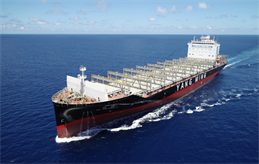
Yang Ming Marine Transport Corp. (Yang Ming) announced it was able to cut its carbon dioxide emission (CO2) by half last year, accomplishing the IMO target of reducing carbon intensity by at least 40% by 2030.
In a statement, Yang Ming said in 2019, its fleet’s average carbon intensity (CO2 emissions per transport work) per TEU/km significantly reduced by 51% compared with the level in 2008, from 99.4 g/TEU-km to 48.1 g/TEU-km, eleven years ahead of the schedule set by the IMO.
The Taiwanese shipper noted to achieve the pursuit of global sustainability and respond to customers’ growing awareness about environmental issues, it has formulated plans to build an eco-friendly fleet a decade ago with the aim to proactively enhance ship energy efficiency and reduce greenhouse gas (GHG) emission.
"Through continuous fleet optimization, Yang Ming has fulfilled its promise of energy saving and emission reduction," it said in a statement.
GHG emission plays a critical role in climate change mitigation. IMO has adopted strict regulations to address the issue and set the goals to cut global shipping carbon intensity by at least 40% by 2030 and 70% by 2050 when compared to 2008.
Long term strategies in place
Yang Ming said it has formulated several long-term strategies, including implementing 12 vessel modification and optimization projects and accelerating the vessel renewal plan by eliminating vessels over 20 years of age.
It also added ten 2,800 TEU class, twenty 14,000 TEU and fourteen 11,000 TEU class echo-friendly smart vessels.
Yang Ming said it also cooperated with weather service provider Weathernews Inc. (WNI) to build a monitoring system to manage fuel consumption and reduce GHG emission, and further evaluate the possibility of developing dual-fuel engines such as LNG or other engines that can perform with carbon-neutral alternative fuels.
As for sulphur oxide emission, Yang Ming ensured an early transition to using low sulfur fuel oil at Kaohsiung port and Shenzhen port in 2018.
In the fourth quarter of 2019, Yang Ming’s fleet has switched to very-low sulphur fuel oil (VLSFO) with sulphur content lower than 0.5% and reduced sulphur oxide emission by 80% compared to traditional heavy fuel oil.




